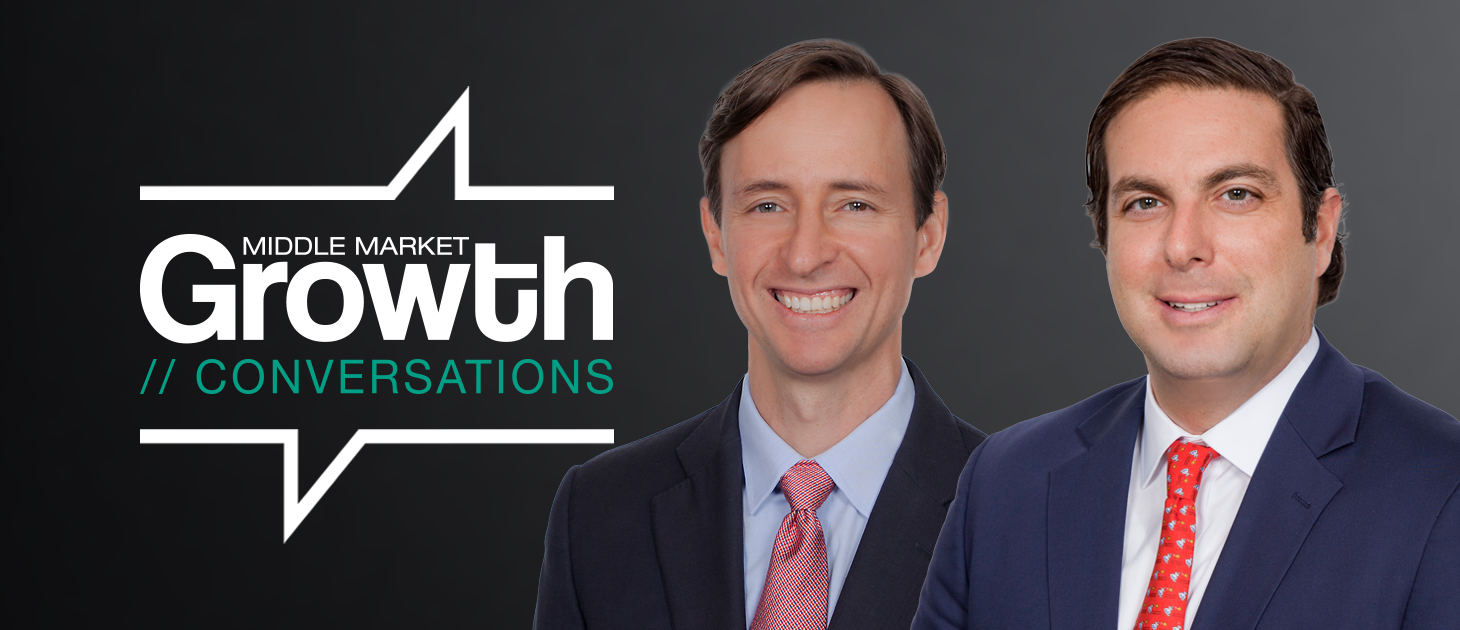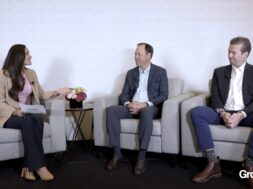Navigating the Competitive Private Credit Market
WhiteHorse Capital's Javier Casillas and Samuel Goldworm discuss staying ahead of the curve in a crowded market

Private credit has been on a rocket ride since the great financial crisis, and the direct lending space has recently become white hot with new entrants joining legacy firms. WhiteHorse Capital’s Chief Credit Officer Javier Casillas and Managing Director Samuel Goldworm join the podcast to discuss how WhiteHorse stays competitive in a crowded market and share their thoughts on the regulatory rumblings around private credit.
This episode is brought to you by WhiteHorse Capital, the direct lending arm of H.I.G. Capital. To learn more about WhiteHorse, visit whitehorse.com. Read a transcript of the podcast below.
Middle Market Growth: Welcome to the Middle Market Growth Conversations podcast, I’m Katie Maloney. The private credit market is booming right now and it’s attracting many new entrants as well as regulatory scrutiny. Here today to discuss the private credit world and how WhiteHorse Capital is navigating the competitive landscape are my guests, Javier Casillas, chief credit officer, and Sam Goldworm, managing director, both with WhiteHorse. Sam and Javier, welcome to the podcast.
Sam Goldworm: Thank you for having us.
Javier Casillas: Thank you, Katie.
MMG: So Sam, let’s start with you. Can you set the stage by telling us about WhiteHorse Capital and the strategies the firm uses to stay competitive in today’s private credit market, even as so many new entrants are coming into the space?
SG: Sure, I’d be happy to. So WhiteHorse Capital is the private credit arm of HIG Capital. HIG is a $60 billion plus alternative asset manager founded by a former Blackstone private equity partner and a Bain consulting partner over 30 years ago. At WhiteHorse, we operate out of a pool of capital of about $12 billion, which means we make loans in the range of, call it $30 million on the low end up to close to $300 million on the high end. We’re split probably 30-70 non-sponsor to sponsor, and when we say non-sponsor, we have been great financial partners for entrepreneurs, family-owned businesses, family office-owned businesses, small public companies. And we also have had a lot of success with independent sponsors, and we put that category in the non-sponsor bucket as well. We do have a robust sponsor business—it’s about 70% of the capital we deploy on an annual basis. Industry-wise, we tend to do everything except project finance or real estate-based finance, because we have groups within HIG that do that.
In terms of how we stay competitive in what is a white-hot market, I think it’s threefold. One is we have a very wide and deep origination effort. We have over 20 originators spread all over the country in places like Ohio and DC, as well as more marquis cities like Chicago, Atlanta, New York. And when we put those individuals in those cities, they tend to be from those cities and tend to have embedded networks that help for a competitive process. For example, my partner Jay in Atlanta is from Atlanta. My partner Matt in LA is from LA. My partner Peter is from Chicago. And that certainly helps. Secondarily, I’m often asked by LPs: With so many entrants in the private credit space, hasn’t it gotten so competitive? True, but we also emphasize that with every private credit entrance, there’s also a new private equity entrance and a new investment banking or intermediary effort. And so we’ve been very good about getting to those new institutions and being a trusted partner with them early and often. And the last part is I think we have been known as a reliable surety of closing type organization, and that reputation has bled into the market. So we tend to be a first phone call for sometimes a situation where timing is of the essence, or if it’s a complicated situation where we can be helpful to a sponsor or non-sponsor borrower who needs someone to unpack a situation fast.
MMG: Thanks for that background, Sam. I want to come back to your point about WhiteHorse’s affiliation as part of a larger alternatives platform. Javier, can you describe the advantages and disadvantages of that relationship and that structure?
JC: Of course, and touching on one point from the question before, I do think a competitive advantage is having been in the market for a long time. So I like to say that here at WhiteHorse, we’ve been doing direct lending since before it was cool, back since 2010. And really, it was a direct outgrowth of the work that HIG was already doing in that middle market, in the lower middle market. I think being part of a larger platform does have some very significant advantages. Sam touched on this scale, physical scale, being in a lot of cities—that would only be possible if there were efficiencies that went along with sharing some of those offices with other strategies, having the existing relationships to be able to hire talented people in those markets, etc. And that makes a big difference in being able to originate deal that aren’t necessarily heavily competitive and marketed.
The second is a very deep catalog of industry and vertical expertise. This firm has owned hundreds of companies, has industry groups that have very specific points of view on which industries are interesting and not interesting, which subsectors you can lean in on and which ones you shouldn’t. And we collaborate with all of those people, and the incentives to collaborate across the platform, both geographically and asset-wise, are hardwired into how we’re all compensated. So when you think about, and we speak about this with our limited partners all the time, when you think about competing with standalone direct lending shops, those are some advantages that would be really impossible to garner if you just started the strategy on a greenfield basis and advantages that we’re really blessed to have.
MMG: Sam, turning back to you—both you and Javier touched on this a little bit, but I was hoping you could talk a bit more about how WhiteHorse structures its team.
SG: We believe in a bifurcated model in that we have originators and have an execution team. The originators are spread out around the country, bringing in as much deal flow as possible and trying to filter it at the front end. And if at that juncture, the originator feels like it’s a quality opportunity, we staff a credit team to do a fair amount of diligence and bring it to a committee. We have a very concise investment committee that is quite honestly a single blackball effort, so we need to have everyone agree that this is a good opportunity to pursue. We think that eliminates groupthink, we think it precludes originators from bullying a deal team into doing a bad transaction. So we have a very strong execution team that helps originators evaluate opportunity, put in presentation form to discuss in investment committee. And Javier is the chief credit officer in-house who runs that execution team. It’s quite deep—we have 71 investment professionals working at the firm within WhiteHorse, and a deal team would normally consist of three to five individuals, depending on the complexity. So it would be an originator partner, an execution partner, as well as usually two to three support execution resources. And so we find that eliminates transactions that go wrong and allows us to go eyes wide open into a transaction of potential risk down the road, how we would handle it, and also to get speed and certainty to our borrowing clients. I think because we meet so frequently as a committee, generally two to three times a week, we can get LOIs out to intermediaries and their clients rapidly and move on efforts that need capital expeditiously.
MMG: And in your view, Sam, is it preferable to have a centralized origination footprint or a more distributed one when dealing with the borrower universe?
SG: I probably sound like a dinosaur here, but I think we firmly believe as a firm that you need to be out there meeting, shaking hands with management teams, meeting, shaking hands with intermediaries, and not only discussing the WhiteHorse message, but understanding these people’s companies. And there’s only so much that can be done via Zoom. So we believe in having a very wide and deep origination effort. I always joke with some of our LPs that it’s not uncommon to see another WhiteHorse colleague at an airport lounge at JFK or Dulles or O’Hare because we are constantly going out there meeting these people. We feel like it’s important to have a spread out effort to have the opportunity to meet intermediaries and management teams, and so we firmly believe that there are opportunities that are regional and that we need to have a regional presence to field those opportunities and analyze these opportunities and execute these opportunities in a rapid fashion.
MMG: And when it comes to due diligence, Javier, what are some of the advantages and disadvantages of organizing the team around industry verticals?
JC: I think when deciding on team structure vertical-wise, you have to take a couple of things into consideration. One is, is there enough volume in a particular vertical to make it worth specializing? And then the second is, does that particular space really require specialized or technical knowledge in order to be successful? And so we’ve determined a few sectors where that is the case, namely healthcare, technology, logistics, e-commerce, and those are all space where [when] a deal comes in, there are subsectors within each of those verticals, the sector lead can decide whether that’s a good fit for what we’re trying to do, whether it’s a space you should try to stay away from, can generate comps based on the hundreds of deals that we’ve already seen and then come back fairly credibly and fairly quickly to our counterparty with an indication. So one of the big advantages is a speed and a crisp response, which I think counterparties really appreciate.
The second significant advantage is that you can avoid losses. I think a lot of direct lenders take their worst losses when they are acting as tourists in a new space that has some real complexity. One example that comes to mind is anything that has to do with government-reimbursed healthcare. There are a lot of deals that seem really attractive on paper, but have some fairly binary and hairy risks around regulation and reimbursement that you may not catch if it’s the first deal that you do in that space.
And then finally, one of the I wouldn’t say disadvantages, but considerations, is that from a career development standpoint, you do want credit investors to have broad exposure to the team in different sectors and different situations. So we tend to ask people to specialize later in their careers once they’ve already done a lot of credit investing and been around for several years within the firm. That tends to be a pretty tried and true way of creating what we call a sort of soft vertical organization where you think about it both in terms of, is it appropriate for a particular vertical, but also is it appropriate for the particular person that is growing through or having a trajectory through your organization.
MMG: And can you talk about the ideal structure for handling work-out situations, Javier? Is it better to have in-house specialists or do you typically rely on deal teams and outside parties?
JC: No, good question. I think you need both and I would add one variable that I do think it’s important to keep the initial credit team on deals when they get troubled because that’s where the original underwriting expertise lies and frankly it creates some accountability for doing bad deals, so you have to eat what you cook if you will. The reason to have specialized expertise in house, which we do—our partners, David Indelicato, leads that effort—is because you need to have consistency and speed around how you deal with similar situations. The best example is probably COVID, where you have a lot of borrowers asking for very similar things, and you need to be providing consistent messaging to the market around what your philosophy is around different asks. And that was extremely healthy in that period of time and something we continue to do since then. A lot of these asks are very normal and recur and so that’s one area where having the specialist helps because you’re emitting the same message. But then there are also situations as work-outs sometimes further develop where you need outside parties to either help you with a certain mode of analysis or data collection or very technical legal matters with respect to, for instance, seeking remedies where you absolutely need smart outside parties that you’ve worked with consistently. One example would be having a stable of independent directors that you can place on boards when necessary. So having folks you’ve worked with in the past and are constructive and responsible with respect to those situations is important and actually harder than you would think in terms of being able to identify quality folks for those roles. So it’s really a little bit of both, but I would emphasize that ultimately you need a conductor, if you will, that sits on top of the several work-out situations that you have at any given time to make sure that we’re acting consistently with the philosophy that we have around those situations and also managing our outside parties in an effective manner.
MMG: And then building on that, Javier: In these situations, how do you balance the needs of both your borrowers and your investors?
JC: If I understand the question correctly, I think it’s probably around how appropriate it is to be really proactive in work-outs and sometimes, unfortunately, that is in a way where you’re across the table from the folks that you originally partnered with. And that is a fact of life that happens from time to time, I would say that in 90% of cases, you’re actually quite aligned with the owners of the business in trying to develop a recovery because obviously the owners of the business will experience a total loss unless you experience a good recovery as the senior lender. And whether that means a change in strategy at the company, restructuring of overhead, those are all things that our partners tend to be quite good at doing. That being said, there are times when those interests become misaligned, perhaps because the only way to achieve an equity recovery is through a fairly aggressive and risky strategy, let’s say with respect to capital expenditures, but in a way that creates a probabilistically worse outcome for the lenders. Then, your first duty there is to have a constructive and transparent conversation with your owners. And to the extent that you recognize that misalignment is not reconcilable, I think that’s where you really have to start thinking about a recovery and protecting the best interests of your investors, and that can take many forms. And unfortunately, all direct lenders end up owning companies from time to time. When that happens, you need to be prepared to really operate those companies. Fortunately, our work-out team has a seasoned professional who formerly did private equity here at HIG and is perfectly capable of making difficult decisions within those companies to maximize their recovery for our investors. But it is important for you to be willing to do that and to ultimately be able to do that in order to have the negotiating capacity to realize the best outcomes and recoveries for your LPs.
MMG: And then finally to close us out, I would be remiss not to ask about regulation, which is a really hot topic right now. With the proliferation of private credit in recent years, there’s been greater scrutiny and calls for increased regulation in some corners. Javier, how would you respond to the concerns about risk and some of these calls for more guardrails?
JC: Yep, timely question. I think there’s a balance—just to provide some context, when we started our direct lending business in 2010, in kind of the back end of the great financial crisis, the space really began to grow as a function of government regulation, which was intended to de-risk banks and for good reasons. Banks are very highly leveraged. They use depositor money to make loans, and many of those banks are systemic with respect to the broader economy. And direct lenders are none of those, which is great. So I think it’s actually been a policy success that the private credit world has grown as much as it has in that, you know, our investors are institutions, endowments, accredited investors. We’re not using depositor money. Our leverage is quite limited. I think that there was a recent IMF paper that talked about private credit regulation and it acknowledges those benefits of this risk residing within the private credit markets relative to the regulated bank markets. I think the other side of that coin is, of course, that as the sector grows, there are appropriate safeguards around valuations and marks, investor disclosures, all of which are things I think that the SEC is absolutely focused on already with respect to private investing in general, including private equity. And I think that organizations that have been in public markets already through publicly traded BDCs really have a big advantage in that sense. So I think it’s a two-sided coin, but I do think that on balance, the growth of direct lending is frankly a regulatory success as opposed to something that we should really worry about and try to further restrict.
MMG: All right, great. Well, we’ll wrap things up there. Javier and Sam, thank you so much for joining me on the podcast.
SG: Thank you.
JC: Thank you, Katie.
The Middle Market Growth Conversations podcast is produced by the Association for Corporate Growth. To hear more interviews with middle-market influencers, subscribe to the Middle Market Growth Conversations podcast on Apple Podcasts, Spotify and Soundcloud.


